Aubrieta: description of species and varieties, cultivation features
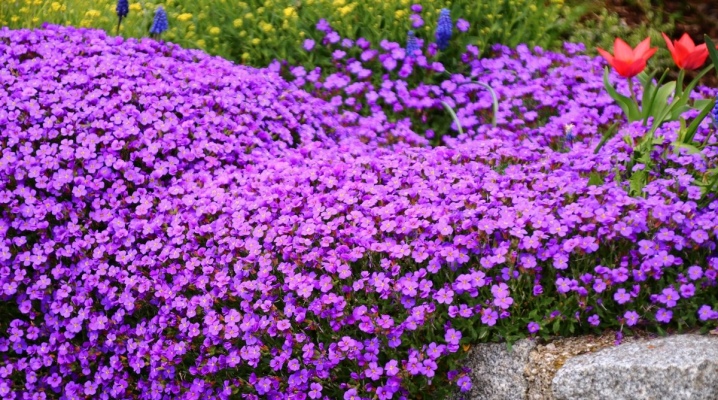
Among evergreen horticultural crops, Aubrieta occupies a special place. This flowering plant does not require specific care conditions, it takes root well even on depleted soils and has small but numerous inflorescences of blue, purple, red and white flowers. In this material, you will get acquainted with the description of popular types and varieties of aubrieta, as well as learn about the intricacies of growing this flower.
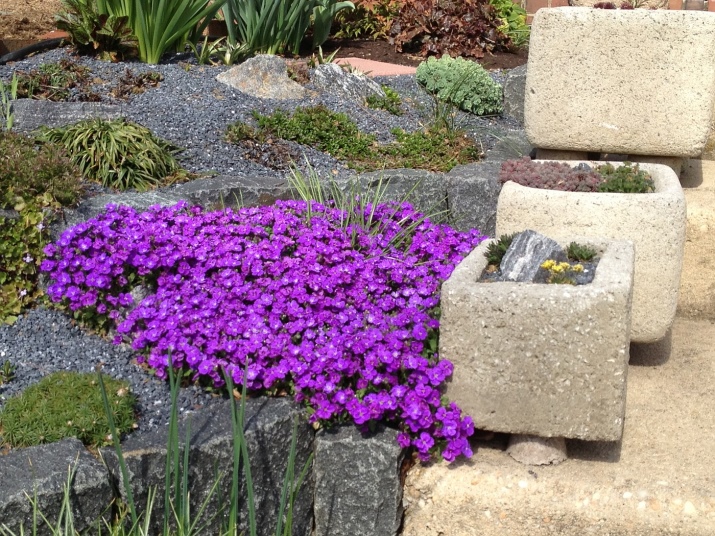





Description
Aubrieta (or aubretia) refers to a perennial evergreen herb from the cabbage family. This flower garden crop is distinguished by its small height (up to 20 cm), as well as small inflorescences of pink, purple, white or azure color. Aubriet leaves are endowed with cloves or have a solid structure. The flowering period of this perennial takes place in 2 stages. The first, depending on the variety, occurs at the end of spring or summer, the second at the beginning or middle of September.
Today, this culture is actively cultivated precisely for decorative purposes and is often used in the creation of landscape design for gardens, loggias and summer cottages.
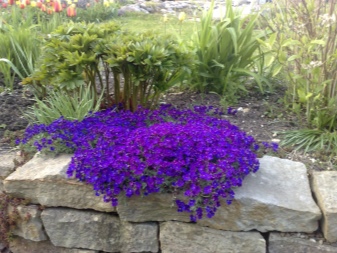
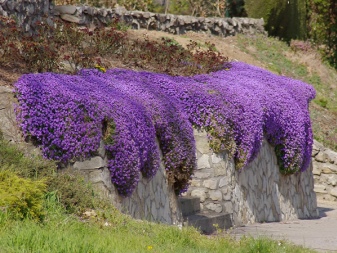
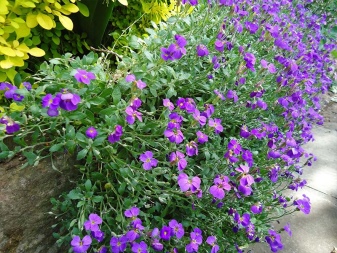

Overview of species and varieties
To date, scientists have identified about 17 independent types of obriety, however, gardeners are actively using the varietal diversity of only two of them: deltoid and cultivated varieties. Below will be considered the key features of these species, as well as the main varieties of aubretia and their external characteristics.



Deltoid
This type includes undersized varieties (up to 15 cm) with racemose purple or lilac flowers up to 1 cm in diameter. The leaves are pale green, ovoid, with characteristic teeth. The variety is distinguished by a long flowering period, which occurs in early summer or late spring.
This is one of the oldest types of obriety - it was first cultivated at the beginning of the 18th century. It is from this species that all existing varieties of hybrid aubretia were formed.

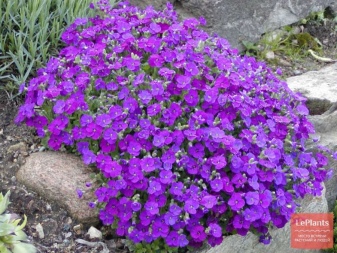
Cultural
This group of aubretsia includes all hybrid varieties of this plant that do not exceed a height of more than 20 cm and are distinguished by excellent winter hardiness. Besides, this variety is characterized by small oblong leaves that are slightly serrated at the edge... Flowers are distinguished by a large number of lilac or purple inflorescences up to 10 mm in diameter. The variety includes double and standard varieties, as well as crops that can be grown both outdoors and in an apartment.
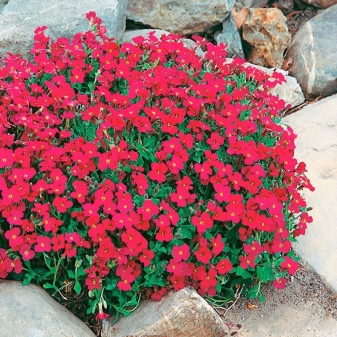

Gardeners refer to several names for the most common varietal crops of hybrid aubriet.
- Cascading. These plants have purple, pink, azure or red inflorescences with a characteristic yellowish core. A distinctive feature of this variety is the preservation of the color of shoots and leaves throughout the year - even in winter, these flowers retain their greenery. The variety can also be recognized by its gray-green leaf blades.
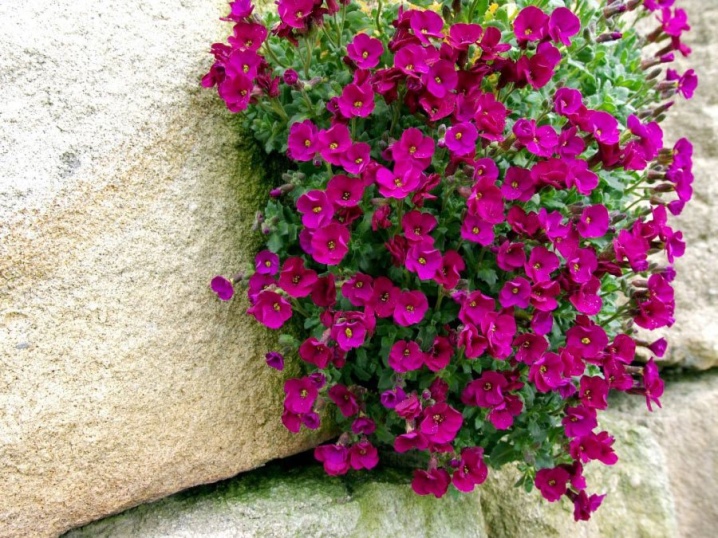
- Cote d'Azur. A feature of this variety is the long flowering period, which lasts during the first two summer months, and then lasts from mid-September until the onset of winter frost.
The variety got this name due to the azure or sky shade of small flowers. The leaves of this plant are also small, light green in color.
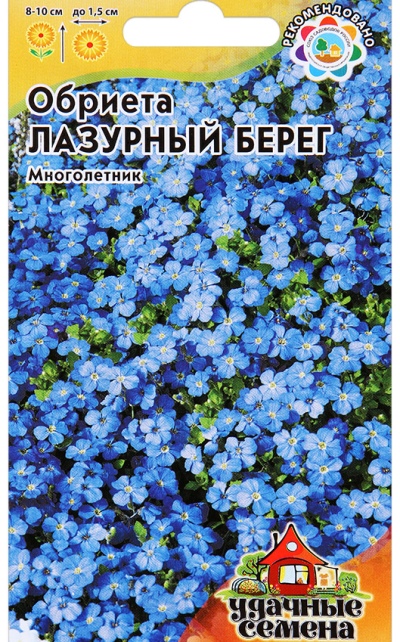
- "Fascinating Morocco". Unlike other varieties, this plant has lush buds of rich red, blue or pinkish color. A distinctive feature is the large flowers up to 1.5 cm in diameter. The color of the leaves is light green.
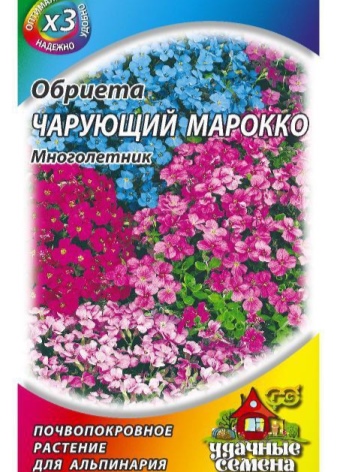
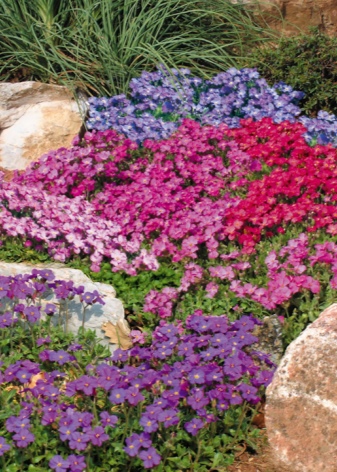
- "Purple Cascade". This variety is distinguished by small oblong leaves with denticles along the border, as well as small purple inflorescences up to 10 mm in diameter. The variety is popular due to its large number of bright flowers, as well as its long flowering period (1.5 months), which begins in May. This flower prefers open, sunny areas with neutral, depleted and light soils and good water permeability. In the autumn, flowering resumes and continues until frost.
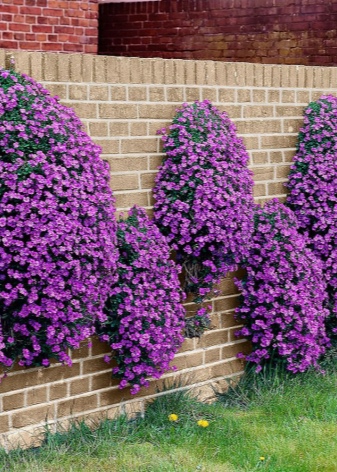
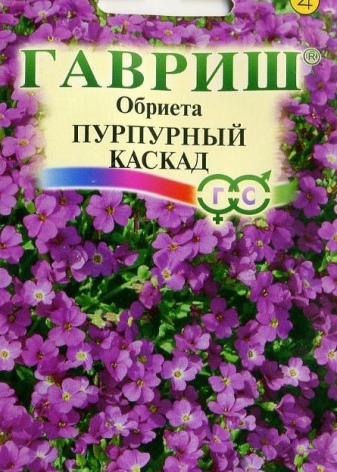
- Campbell. Lush low-growing plant (up to 10 cm) with large purple or azure inflorescences up to 1.5 cm in diameter. The flowering period also occurs in May and lasts about 1-1.5 months, then resumes in the fall.
It is with the help of this variety that garden paths and borders are decorated.
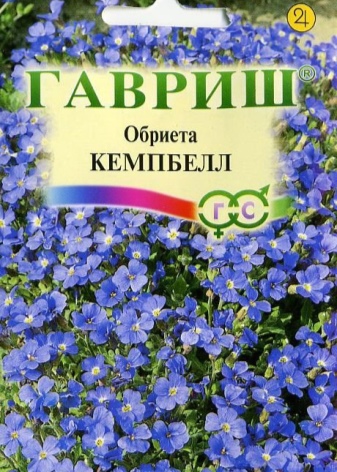
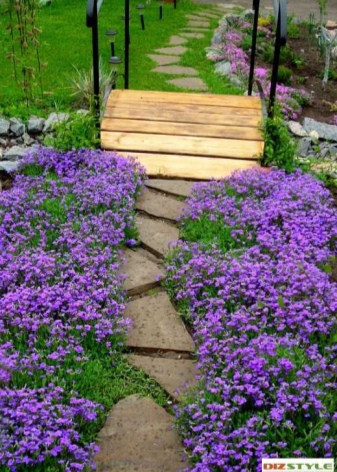
- "Giant Falls". It is a mix of different varieties of obriety, which is distinguished by purple, pink or burgundy flowers up to 1 cm in diameter. Includes fairly tall plants that can grow up to 15 cm in height. In addition to external qualities, such flowers are distinguished by excellent frost resistance, which allows them to bloom even in autumn frosts.
Gardeners often decorate single flower beds, garden paths or curbs with this mixture of abretion colors.


- "Blue cascade". One of the most popular and lush varieties in decorating voluminous flower beds or rock gardens. It is characterized by numerous dark blue flowers with a yellowish or white heart. The maximum height of the bushes is up to 15 cm.

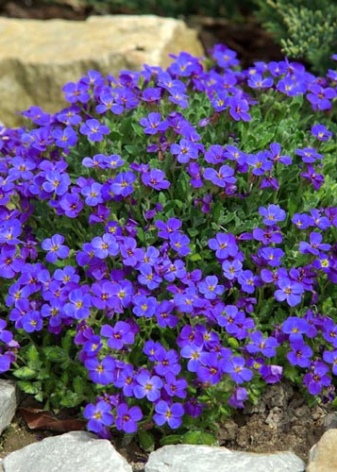
Boarding and transfer rules
Even an inexperienced gardener can handle planting aubriets - this is an extremely undemanding and simple flower when it comes to planting in open ground. Below we will consider the intricacies of planting seedlings and seeds of aubretia, as well as the features of transplanting this garden culture.

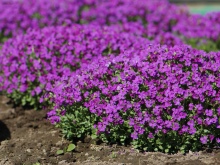

Planting seedlings in open ground
Gardeners prefer to plant aubriet seedlings in April or May, when long spring frosts have already passed. An open and well-lit place on the north side of the garden is chosen for planting.
Both fertile and depleted soil are suitable for a plant - in this sense, shaved is absolutely picky. The main condition for the type of soil is that there must be good air and water permeability, therefore ash, sand and peat are added to heavy soils with a high clay content, which allow water to be absorbed more efficiently and not linger at the roots of the plant. As for the composition of the soil, neutral or slightly acidic soils are suitable for the growth of healthy and abundant flowering.
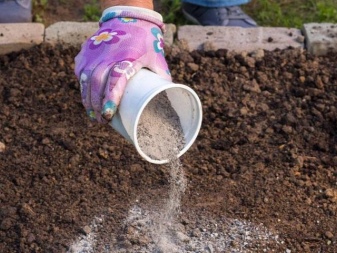
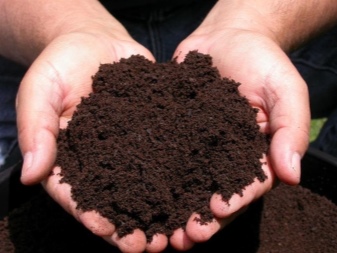
The further process of planting shaving in the garden includes several stages.
- Before planting seedlings, containers with seedlings are lowered into water. When oxygen bubbles appear on the surface of the pot, the plant is carefully pulled out and by transferring it is installed in the prepared hole on the site.
- The depth of the hole should be chosen based on the age of the seedling and the size of its root system. In width, it should be slightly larger than the size of the earthen coma from the mother container.
- At the bottom of the hole, a drainage layer is organized, after which the seedling, together with an earthen clod, is installed on top of it, and the holes formed are filled with fertile soil from peat, meadow soil and sand. After filling the holes with soil, the soil in the trunk circle is compacted and watered, a layer of mulch is organized.
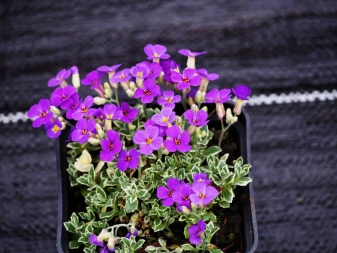
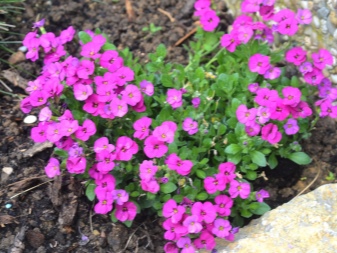
Planting seed
Experienced gardeners already prefer to plant in open ground not shaved seedlings, but seeds. Before such planting, the soil at the planting site is subjected to special treatment.
- The soil at the landing site is dug up to a depth of 15 cm, while all weeds, old roots and stones are removed from the soil.
- Top dressing is introduced into the ground in the form of lime or ash. Then the soil is carefully dug up and moistened so that the top dressing is absorbed.
- The seed is planted directly on the surface of the ground while maintaining a distance of 7-10 cm.The seeds can be pressed slightly, and then be sure to sprinkle with a layer of fine sand 3-5 cm thick.
- The area is watered abundantly with a spray bottle or watering can.
- If you planted the seeds in a warm spring and ensure regular watering, then the first shoots of the aubriet should appear in 2-3 weeks. When sowing seeds for the winter, wait for the first shoots no earlier than next spring.
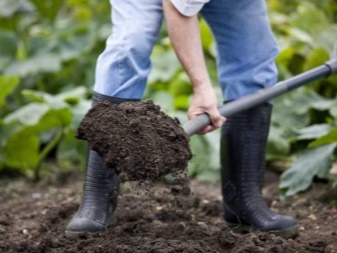
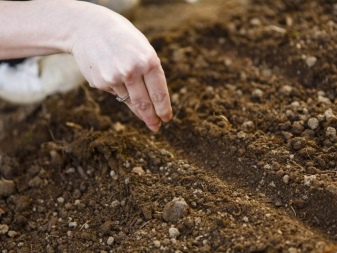
Transfer
Transplant Aubrieta to another place possible in three cases:
- during reproduction by dividing the bush;
- with the growth of the maternal adult bush;
- and also in the case of buying a plant in a gardening store.
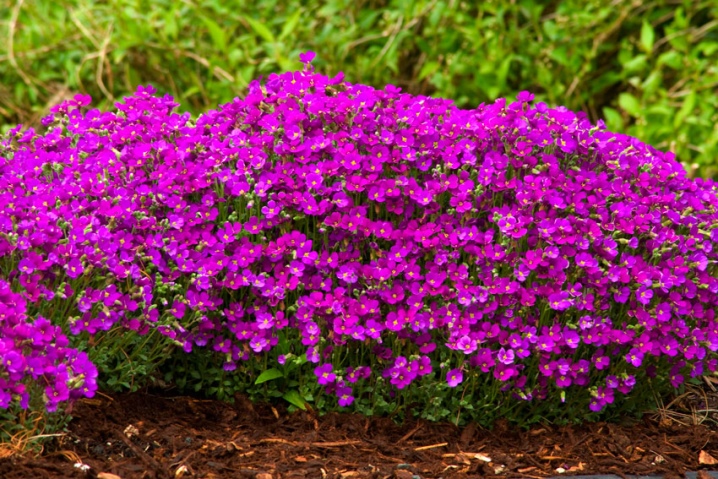
It is worth saying that the transplantation of an aubriet is not particularly good - in most cases, the transplanted plants take a long time to take root in a new hole or wither. It is for this reason that the picking of this garden plant is undesirable, and the planting of seeds for seedlings is carried out in separate pots, and not in large containers.
Usually, aubretia transplant is carried out no more than 1 time in 2 years in the case when the container with the plant ceases to contain its roots. When growing aubretia in a garden plot, this can be seen by the root shoots, which will be knocked out to the surface of the earth.
The procedure itself is carried out in the spring, before the period of active growth and flowering. In order for the plant to quickly take root in a new site, the same substrate is placed in the hole, and the temperature at the planting site must be identical to the temperature of cultivation in the previous place.
After planting, the flower is watered abundantly and potash fertilizers are added to the soil.

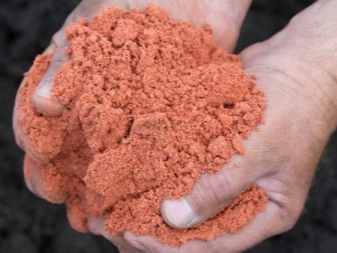
Care features
Aubrieta is appreciated among gardeners not only for its beauty, but also for its unpretentiousness to the conditions of planting and growing in a flower bed and at home. This is a relatively self-sufficient plant that does not need regular watering, does well without additional fertilizing and loves to grow in marginal soils.

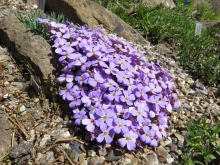
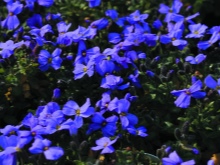
Watering
The intensity of irrigation of the aubriet varies greatly depending on the age of the plant and the external climatic conditions. For example, if an adult and developed plant is at the disposal of the summer resident, then it will need watering only in the summer season when the soil in the near-stem circle of the plant dries up. Young plants and only planted aubretia need frequent watering until they acquire their own root system.
In regions with regular and frequent rains, additional watering is not needed for shaving - with an excess amount of moisture and a favorable temperature, the number of leaf plates increases and the number of buds decreases.
To prevent moisture from stagnating in the roots of the shrub, a drainage layer is organized in the planting holes.
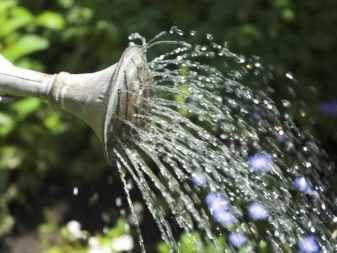
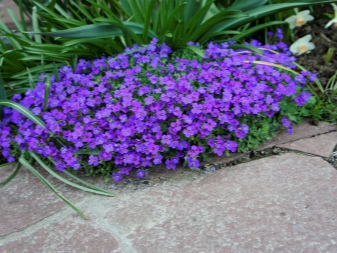
Top dressing
Most varieties of obriety are freely grown in summer cottages and without adding additional fertilizing to the soil. To extend the flowering period or stimulate the appearance of inflorescences, potash fertilizers are applied to the soil 2 times a season. It is advised to feed only adult or already grown shrubs. The best time for feeding is considered the beginning of the flowering period - to stimulate the growth of flowers, and the period after the pruning procedure - for a painless wintering.
In general, aubrets grow well on poor soils, and therefore do not need complex fertilizing. It is believed that it is best to choose mineral or potash fertilizers for feeding these flowers - he does not like feeding with nitrogen.
According to gardeners, wood ash is the best way to feed this horticultural crop.
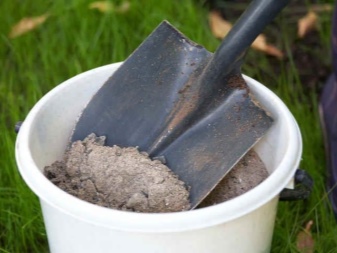

Pruning
Pruning is a natural process when it comes to growing aubrietta. There are 2 types of pruning abretion: health and decorative. In the first case, the plant is cut off every spring after the flowering period - all the shoots of the plant are cut off almost to ground level. This will give rise to new green shoots and re-bloom in the fall.
Decorative pruning involves the regular removal of dried and withered shoots, leaves, or buds. This not only improves the appearance of the shaved, but also directs the juices to the development of young shoots and the emergence of new flowers.
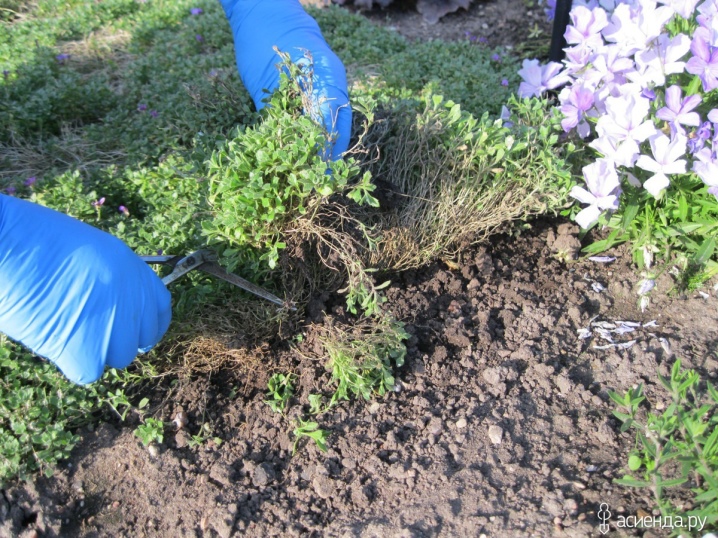
Some gardeners prefer to prune aubrieta for the winter, but this procedure is optional. This plant does not throw off foliage with the onset of frost and can tolerate even prolonged frosts perfectly.
Experts advise covering such flowers for the winter to prevent damage to the appearance of the aubretia and rotting of the shoots. Spruce branches, fallen leaves or straw are best suited for shelter.
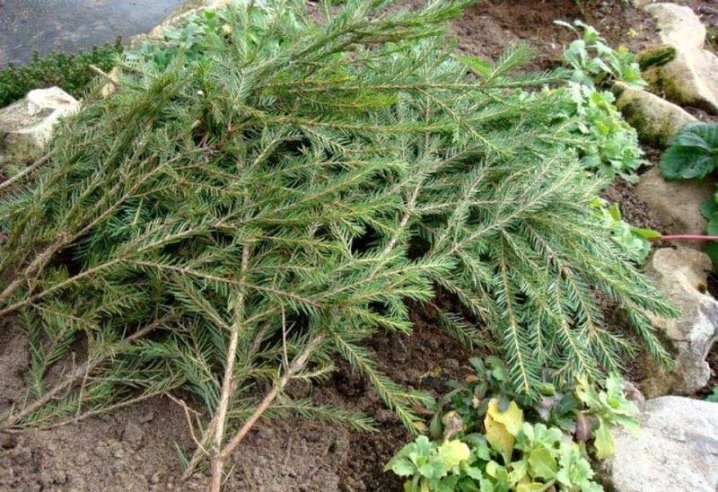
Breeding options
Gardeners who grow aubrieta outdoors usually use only 3 methods of propagation of this flower: cuttings, dividing a bush and growing from seeds. Each of these methods should be considered in more detail.
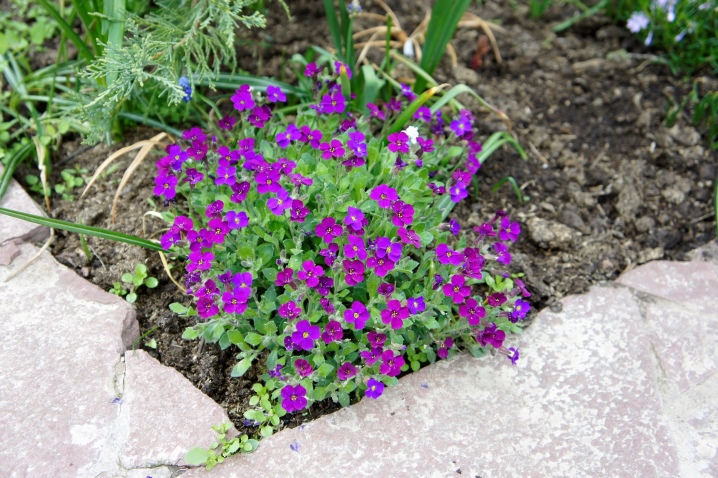
Cuttings
Reproduction of aubriets using cuttings is considered the most popular today. During summer pruning (after the first flowering), a large number of strong and green shoots without inflorescences remain on the plant, which can be used for planting.
When planting cuttings in open ground, it is advised to build a special greenhouse, as well as prepare a substrate from peat and sand. In the greenhouse, plants are regularly watered, and the condensation formed on the walls is removed - so as not to get on the leaves and not burn them.
Cuttings are usually planted in a permanent place as soon as they acquire their own roots.
If cold autumn and little snowy winter are observed in your region, then it is better to leave the cuttings in a greenhouse until the next spring - this will allow them to get stronger and develop a more powerful root system.
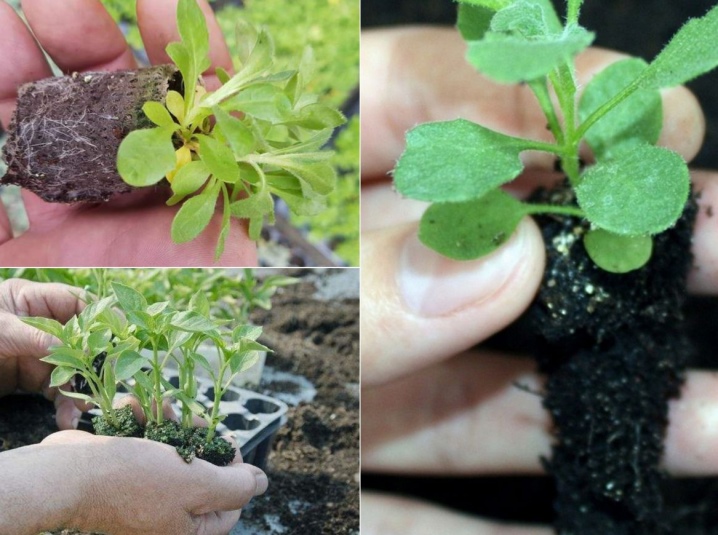
By dividing the bush
Dividing the Aubrieta bush is a rather complicated method that not every gardener can handle. The fact is that this plant tolerates this procedure problematically, and the separated bushes do not always take root in a new place.
The division of the aubretia bush can be carried out both in spring and in autumn, and involves a certain sequence of actions.
- The obriety bush is dug up and cleared of the ground, then it is divided into approximately the same small shoots with their own leaves and developed roots.
- If the root ball is too tangled to unravel, it should be split with a disinfected pruner.
- All cut off parts of the shoots are treated with wood ash, and the roots - with a solution for rooting.
- Separated young bushes are planted in separate holes at a distance of at least 10 cm from each other in compliance with the standard procedure for planting aubriet. Before the bushes take root, they are provided with regular watering and feeding.
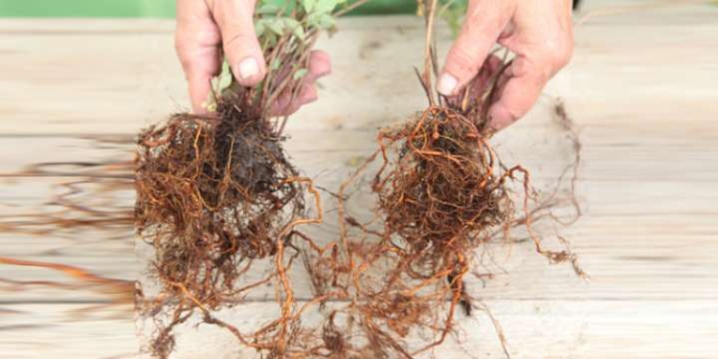
Growing from seeds
Reproduction of aubriets using seeds is not so popular among gardeners - everything is explained by the high time costs for this procedure, as well as the high probability of loss of varietal properties of young plants.
In order to collect seeds for planting, during summer pruning, several shoots with ovaries on the bush are preserved. After the pods themselves darken and dry, they should be cut off, then the planting material should be husked. Before planting seeds in open ground, they should be placed in a warm and shaded place and well dried and ventilated.

Aubrieta seeds are usually planted at the end of winter (ideally in mid-February). The best place for planting would be peat containers with drainage holes (pots). The subsequent procedure for planting seeds at home will include several steps.
- For planting, you should choose a fertile soil from a mixture of peat and sand in a ratio of 1 to 1.
- Before planting seeds, the soil is abundantly moistened, drainage is organized.
- Up to 2-3 seeds are planted in one pot, which are evenly spread over the container and slightly sprinkled with sand. Then the soil is moistened again.
- To create a pleasant microclimate, containers are covered with glass / plastic jars or glass / cellophane film. So that the air in the containers does not stagnate, they are sometimes ventilated.
- In a room with seeds, a room temperature of at least +18 degrees Celsius must be maintained.
- When the first shoots appear, the cover in the form of a film is removed, and the number of waterings is reduced. During watering, you need to try not to damage the fragile seedlings and do not get water on the leaves.
- Picking of these plants is undesirable, but can be carried out after 2-3 full-fledged leaves appear at the seedlings. The actual landing in open ground is carried out at the end of next spring.
- Before planting seedlings in a new place, the site is fertilized with mineral fertilizers and organic matter.
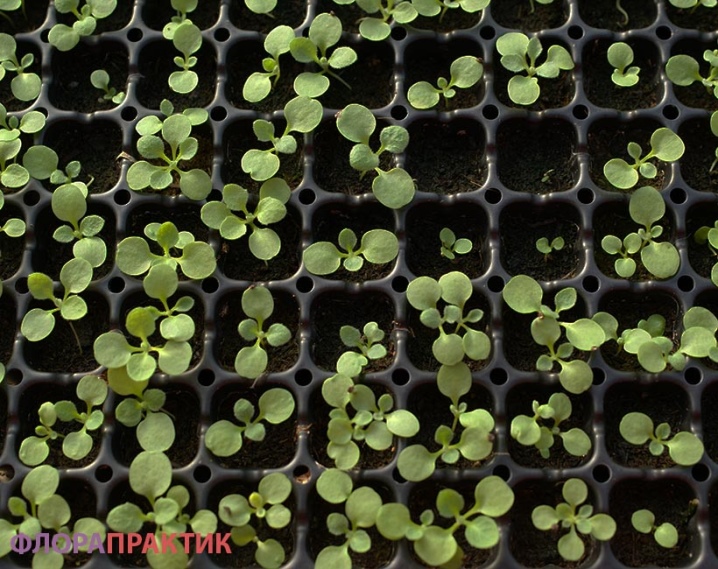
Diseases and pests
Aubrieta is one of the few garden crops that have a very strong immune system and are able to independently cope with most of the fungal and viral diseases.
In rare cases, signs of powdery mildew may be visible on the abretion. - a fungal disease, which is expressed in the appearance of a white bloom on the shoots and flowers of the plant, which turns gray over time. The disease not only worsens the appearance of the flower, but also reduces its immunity. Without timely treatment, the shaving will fade and turn black.
The best way to combat this ailment is to treat the plant bush with a solution of colloidal sulfur. If the infection has gone too far, all painful shoots are cut off.

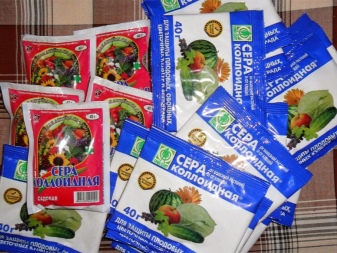
The most dangerous enemy for Aubriets is the common aphid. This pest is easy to recognize by the huge colonies that settle on the shoots and leaves of the plant. Additional signs are: an increase in the number of ants near the plant, the formation of a light and sticky bloom on the shoots, dark dusting on the leaves, shriveled flowers and shoots. Aphids not only weaken the shave and suck out all the juices from the leaves, but can also become a carrier of dangerous viral diseases.
In the fight against these pests, insecticides like "Fufanon", "Fitoverma", "Intavir" or "Karbofos" will help you. In addition, plants infected with aphids can be treated with warm water.
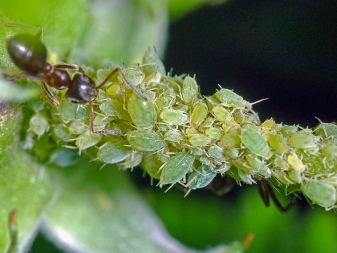

Another pest that can infect Aubrieta or weaken its immunity is the so-called cruciferous flea. A sign of the appearance of these pests is the numerous dark holes in the leaf plates of flowers. The larvae of this pest can be removed manually, in addition, it does not like water very much and does not take root in areas where calendula, garlic, marigolds or caraway are planted.
To help the aubretia to cope with these pests, the plant is fertilized with organic matter or saltpeter.
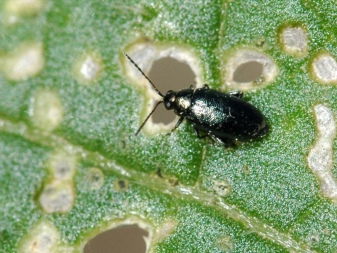
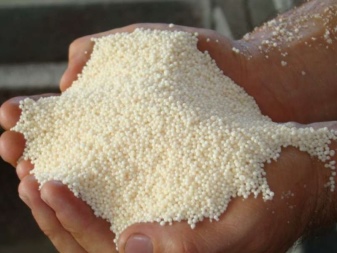
Advice
Below is a small list of tips, which will help you with planting and growing aubrets.
- Aubrieta feels great in direct sunlight, but does not treat strong and cold winds well. Gardeners recommend planting this perennial plant near a brick wall, fence or annex that would protect the aubretion from sudden gusts of wind.
- Try to regularly maintain a favorable level of humidity in the aubriet's trunk circle. This plant does not tolerate moisture stagnation, but it also cannot please you with abundant flowering in dry soil.
- Watering is carried out in the morning or in the evening to avoid exposure to wet leaves and roots of sunlight. You need to water with settled water - after watering, the soil near the bush must be loosened and cleaned of weeds.To preserve moisture for a longer period, a layer of mulch (2-3 cm) of straw, needles, bark or rotted manure is organized near the aubre.

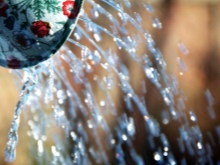

See the next video for even more on growing aubrietta.







































































































The comment was sent successfully.